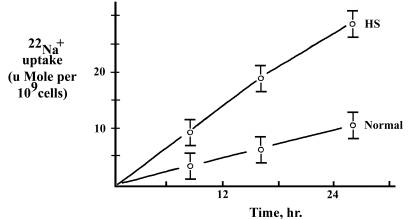Preface | Introduction to Problem Solving | Problem Sets | Acknowledgments
| B.7. RBC Spherocytosis <<Previous Problem | PPrint PDF |
Hereditary spherocytosis (HS), a rare form of anemia in humans, is characterized by slightly spherical red blood cells. Affected individuals have fewer red cells than do normal individuals, possibly because HS cells are more susceptible to osmotic lysis than are normal cells (and because they are more readily trapped by the spleen): when placed in a slightly hypotonic saline solution that would cause little or no hemolysis in normal cells, significant numbers of HS cells burst, as illustrated in the following table:
| Material | % Cells Hemolysing | |
| Normal RBC | 5 | |
| HS RBC | 50 |
To examine the mechanism responsible for HS, investigators suspended samples of normal and HS erythrocytes in identical physiological saline media and measured the uptake of radioactive sodium (22Na) over time. The data are presented in the figure below, as average fluxes +/- 1 S.E.
 |
Consider this data, what you know about plasma membrane
structure and function, and answer the following questions.
A. (4 pts) Why are HS human erythrocytes more susceptible to hypotonic
perturbations than normal cells?
B. (4 pts) Would you expect the Na/K pump to exhibit an activity in HS
cells different than what is exhibited in normal cells, suspended in identical
media? Why or why not?
C. (6 pts) What do these data suggest is the basis for the HS condition?
Propose a physiological mechanism to account for the data.
D. (6 pts) Propose a correlative structural mechanism to account for the
data, using a diagram as necessary.
E. (6 pts) Describe a test of either hypothesis and indicate clearly
how the possible results would test the validity of your hypothesis.